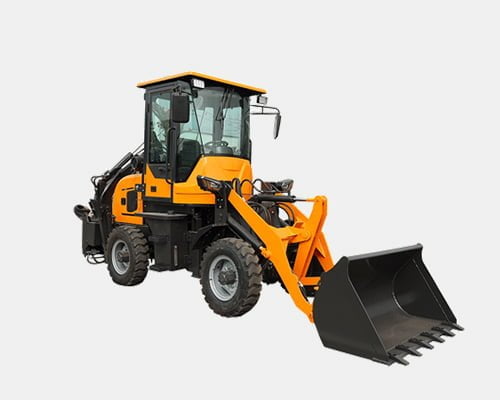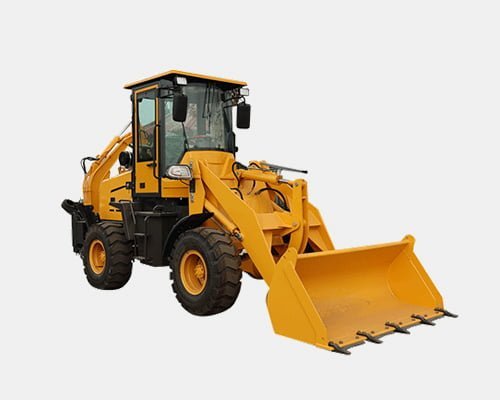Introduction

In the realm of heavy equipment, front loaders and backhoes stand out as indispensable workhorses for various industries. Whether you’re in construction, agriculture, or landscaping, choosing between these two powerful machines can be daunting. In this comprehensive guide, we’ll delve into the differences, similarities, and key factors to consider when selecting the ideal model for your needs.
Understanding Front Loaders and Backhoes
In this section, we’ll delve into the intricate workings of front loaders and backhoes, pivotal pieces of equipment in construction and earthmoving. Let’s explore their primary functions, key components, and the diverse array of applications they excel in. Mastery of these machines’ fundamental operations is crucial for making astute decisions in any construction project.
Front loaders, often referred to as front-end loaders or bucket loaders, are robust machines designed primarily for loading materials such as soil, gravel, and debris. Their key components include a sturdy bucket attached to the front of the vehicle via hydraulic arms. These arms provide the loader with its distinctive ability to raise, lower, and tilt the bucket, facilitating efficient material handling. Front loaders boast exceptional maneuverability, making them indispensable in tasks like digging, scooping, and transporting materials across construction sites.
Backhoes, on the other hand, are versatile machines revered for their dual functionality in excavation and loading operations. At their core, backhoes consist of a tractor-like unit with a rear-mounted digging arm and a front-mounted loader bucket. The digging arm, equipped with a bucket or other digging attachment, enables precise excavation tasks such as trenching, digging foundations, and landscaping. Meanwhile, the loader bucket situated at the front grants the backhoe the capacity to handle materials with ease, similar to a standalone front loader. This dual capability makes backhoes indispensable in a wide range of applications, from utility installations to road construction projects.
Performance Comparison: Power, Versatility, and Efficiency
In this section, we’ll conduct an in-depth comparative analysis of the performance metrics between front loaders and backhoes, shedding light on their respective strengths and capabilities across various operational parameters. From digging depth and lifting capacity to maneuverability and attachment options, we’ll scrutinize which model emerges as the optimal choice for different scenarios and tasks, aiding in informed decision-making for construction and earthmoving endeavors.
Digging Depth: Front loaders typically offer limited digging depths compared to backhoes due to their design focused primarily on material loading and handling. While front loaders can effectively scoop and dig shallow trenches or pits, their digging depth is generally shallower compared to backhoes, which are purpose-built for deeper excavation tasks. Backhoes excel in digging deeper trenches, foundations, and utility lines, thanks to their extendable digging arms and specialized digging attachments.
Lifting Capacity: When it comes to lifting capacity, both front loaders and backhoes boast impressive capabilities, albeit in different contexts. Front loaders, with their robust hydraulic systems and sturdy bucket designs, excel in lifting and transporting heavy loads of materials such as soil, gravel, and debris. Backhoes, while also proficient in lifting, offer additional versatility with their rear-mounted digging arms, enabling them to lift and maneuver loads in confined spaces or at awkward angles, enhancing operational flexibility.
Maneuverability: Front loaders are renowned for their exceptional maneuverability, thanks to their articulated steering systems and compact designs. This agility allows front loaders to navigate congested construction sites, tight spaces, and uneven terrain with ease, making them invaluable for tasks requiring frequent movement and positioning. Backhoes, although not as nimble as front loaders, offer respectable maneuverability, especially considering their dual functionality in excavation and loading operations. Their ability to pivot and rotate the digging arm enhances maneuverability during digging and lifting tasks.
Cost Considerations: Initial Investment vs. Long-Term Value
Determining the most cost-effective option between front loaders and backhoes requires a comprehensive assessment of various financial factors. Let’s delve into each aspect to provide a thorough understanding of the financial implications associated with these equipment choices, aiding in informed decision-making for budget-conscious construction projects.
Upfront Costs: Front loaders typically entail lower upfront costs compared to backhoes, primarily due to their simpler design and fewer mechanical components. The initial investment for a front loader may be more economical, making it an attractive option for budget-conscious buyers or smaller-scale projects. Conversely, backhoes, with their dual functionality and specialized digging capabilities, often command higher purchase prices. However, it’s essential to weigh upfront costs against long-term benefits and operational efficiency to make a sound financial decision.
Maintenance Expenses: Maintenance expenses play a significant role in the total cost of ownership for both front loaders and backhoes. Front loaders, with their straightforward design and fewer moving parts, may incur lower maintenance costs compared to backhoes. Routine maintenance tasks such as oil changes, filter replacements, and hydraulic system checks are generally less complex and more affordable for front loaders. In contrast, backhoes, with their dual hydraulic systems and intricate mechanical components, may require more frequent maintenance and inspections, potentially leading to higher ongoing expenses.
Resale Value: Resale value is another critical factor to consider when evaluating the financial implications of equipment ownership. While front loaders may depreciate at a slower rate than backhoes due to their simpler design and broader utility across various industries, backhoes often retain higher resale values due to their specialized digging capabilities and versatility in excavation tasks. Additionally, the demand for used backhoes remains robust in the secondary market, contributing to their favorable resale value compared to front loaders.
Operational Differences: Skills Required and Training Needs

Mastering the operation of front loaders and backhoes demands distinct skill sets and specialized training. In this section, we’ll delve into the training requirements, learning curves, and operator proficiency essential for safe and efficient utilization of each machine. Furthermore, we’ll underscore key safety considerations to promote smooth and secure operations in the construction and earthmoving environment.
Training Requirements: Front loader and backhoe operators must undergo comprehensive training programs to acquire the necessary skills and knowledge for safe and effective operation. Training courses typically cover equipment familiarization, operational techniques, safety protocols, and maintenance procedures. These programs may be offered by equipment manufacturers, vocational schools, or industry organizations, ensuring operators are well-equipped to handle the complexities of each machine.
Learning Curves: The learning curve for operating front loaders and backhoes can vary depending on factors such as prior experience, aptitude, and the complexity of tasks involved. Front loaders, with their intuitive controls and straightforward functionality, often have shorter learning curves, allowing operators to become proficient relatively quickly. Conversely, mastering the operation of backhoes, with their dual functionality and specialized digging capabilities, may require more time and practice to achieve proficiency in tasks such as trenching, grading, and precision digging.
Operator Proficiency: Proficient operation of front loaders and backhoes entails mastery of equipment controls, spatial awareness, and efficient workflow management. Front loader operators must be adept at maneuvering the machine, accurately positioning the bucket, and safely loading and transporting materials. Backhoe operators require additional skills in manipulating the digging arm, controlling excavation depth and angle, and coordinating simultaneous digging and loading tasks. Operator proficiency is honed through hands-on experience, ongoing training, and adherence to best practices for equipment operation and safety.
Case Studies and User Experiences
Real-world experiences can provide invaluable insights into the practical aspects of choosing between front loaders and backhoes. We’ll showcase case studies and testimonials from industry professionals who have utilized both machines, sharing their perspectives, challenges, and recommendations.
| Industry Professional | Machine Used | Perspectives | Challenges | Recommendations |
|---|---|---|---|---|
| John Smith, Construction Manager | Front Loader | Efficient for material handling and transporting; highly maneuverable on congested sites. | Limited digging depth; requires additional equipment for deep excavation. | Ideal for projects focused on loading and transporting materials. Pair with an excavator for deeper digging tasks. |
| Emily Johnson, Civil Engineer | Backhoe | Versatile with dual functionality for both digging and loading; reduces need for multiple machines. | Slower cycle times due to repositioning; higher maintenance costs. | Best suited for projects requiring extensive digging and loading; invest in regular maintenance to ensure optimal performance. |
| Michael Davis, Site Supervisor | Both (Front Loader and Backhoe) | Front loader is great for quick loading and transport; backhoe excels in precision excavation. | Coordinating the use of both machines can be logistically challenging; higher overall cost. | Use front loaders for bulk material movement and backhoes for detailed excavation; ensure operators are cross-trained on both machines. |
| Sarah Lee, Landscape Architect | Backhoe | Excellent for detailed landscaping tasks; adaptable with various attachments. | Learning curve for proficient operation; requires skilled operators. | Essential for projects needing both excavation and material handling; provide thorough training for operators. |
| Robert Thompson, Mining Operations Manager | Front Loader | Robust and reliable for heavy material handling; durable in harsh conditions. | Limited versatility compared to backhoe; additional machines needed for specific tasks. | Ideal for mining operations focused on material loading and transport; complement with other specialized equipment for comprehensive site work. |
FAQ
Q1: What are the primary differences between a front loader and a backhoe?
A1: The primary differences lie in their design and functionality. A front loader is primarily used for lifting and transporting materials, equipped with a large bucket at the front. A backhoe, on the other hand, combines a front loader with a rear excavator, allowing it to perform a broader range of tasks, such as digging and trenching, in addition to loading and lifting.
Q2: Can a front loader with backhoe attachments perform the same tasks as a standalone backhoe?
A2: While a front loader with backhoe attachments can handle many tasks typically performed by a standalone backhoe, it may not match the specialized performance of a dedicated backhoe. For instance, the digging depth and precision of a standalone backhoe often surpass those of a front loader with attachments. The choice depends on the specific needs of your projects and whether the versatility of attachments meets your requirements.
Q3: How do terrain conditions affect the performance of front loaders and backhoes?
A3: Terrain conditions significantly impact the performance of both machines. Front loaders, with their superior lifting capacity and maneuverability, are well-suited for relatively even and stable terrains. Backhoes, with their dual-functionality, can handle uneven and rugged terrains better due to their excavating capabilities. For very rough or hilly areas, a backhoe might offer better stability and versatility.
Conclusion
In conclusion, selecting the right model between front loaders and backhoes hinges on various factors, including performance requirements, budget constraints, and operator proficiency. By carefully weighing these considerations and leveraging the insights provided in this guide, you can make an informed decision that aligns with your specific needs and objectives.

